This post may contain affiliate links. We may receive a small commission, at no cost to you, if you make a purchase. Read Disclosure.
I’m not sure why sometimes it takes me so long to write about certain places I have been to.
Over a year ago I visited Baan Huay Kee Lek, an ethnic Akha village perched on the top of a mountain in the Chiang Rai province of Thailand. I knew as soon as we drove up the dusty and windy dirt track to the village we were in for a treat.
Isolated, authentic and free from groups of tourists (except for our small group of writers).
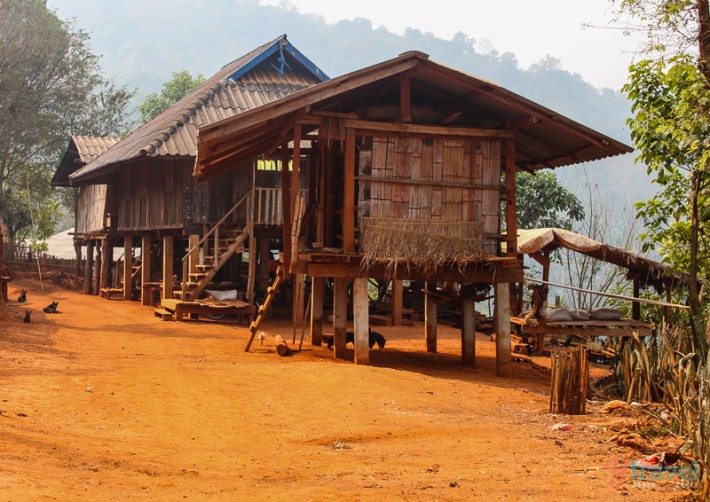
Visiting hill tribe people in Thailand is a popular experience for travellers and many of the hill tribe villages are said to be losing their identity to the tourism industry.
We were the first tourists to visit Huay Kee Lek. The villagers had only recently decided to welcome in the gawkers and in an effort to not lose themselves to them created a counsel to manage it as a community based tourism project.
This is tourism that aims to show the visitor the local traditions, values and lifestyle whilst conserving the value of the individual culture and environment. Visitors can stay overnight or join the rural people in their daily lives in an effort to increase understanding and respect for each other.
This form of tourism allows the villagers to maintain their traditional skills, control the tourism income, pursue their normal life and preserve their cultural and natural heritage.
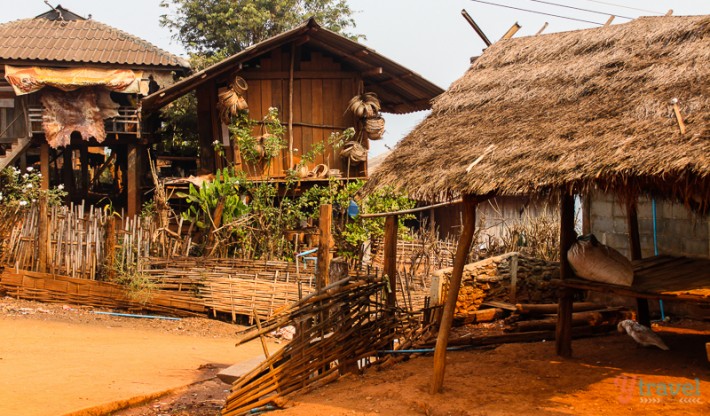 The details of my time here are quite sketchy. It was in the middle of a trip where I experienced so many amazing things. Of course, I had my notebook, where I recorded the intricate details including that of my observations and thoughts.
The details of my time here are quite sketchy. It was in the middle of a trip where I experienced so many amazing things. Of course, I had my notebook, where I recorded the intricate details including that of my observations and thoughts.
My notebook is what helps me recall most stories that I tell. Every now and then disaster strikes and no matter how many lounge cushions you upend and desk drawers you empty out, you just can’t find the notebook that helps tell the story!
Lucky for me, a few major things stick out in my mind still and I have some incredible photos to share.
Life in Huay Kee Lek Village
Despite the authenticity of village life in Huay Kee Lek, many Akha villagers ride motorbikes into Chiang Rai during the day to work in factories, government positions and private businesses. They wear suits or normal clothes. The traditional garments you see are reserved for special occasions, special visitors or for those who continue living in the traditional manner.
Village life still continues in much the same way as it has for years, except modern life is creeping in slowly. And this is fine, evolution happens everywhere.
We saw the mix of old and new with women weaving grass and drying beans in the sun, taxi drivers lazing about on bamboo platforms and young soldiers standing around in groups laughing and chatting.
Pigs and roosters ran round our feet and children played in the dirt in their backyards or under their homes built on wooden stilts.
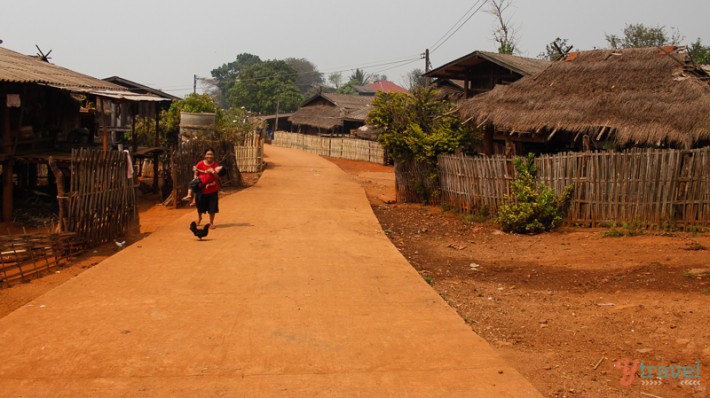
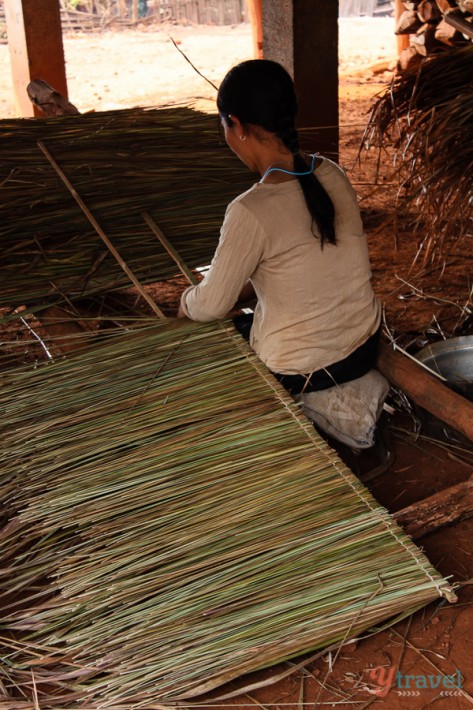
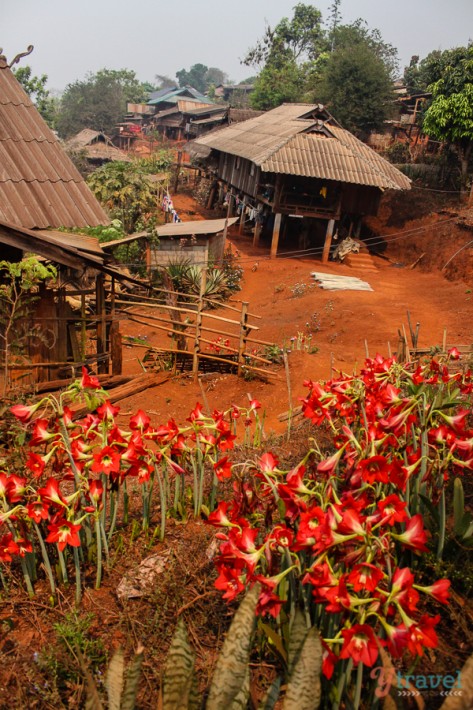
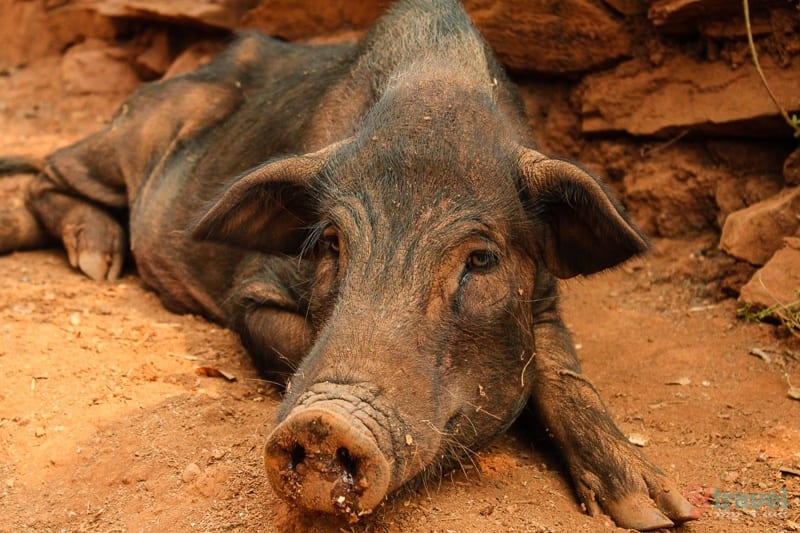
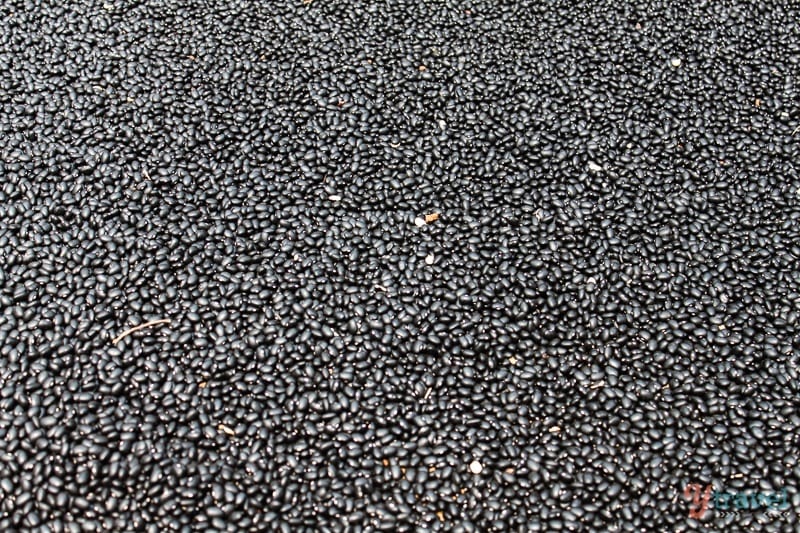
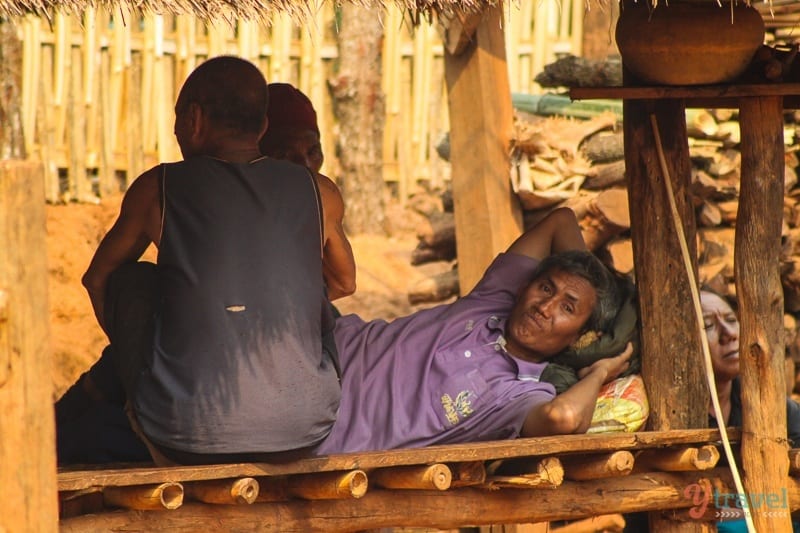
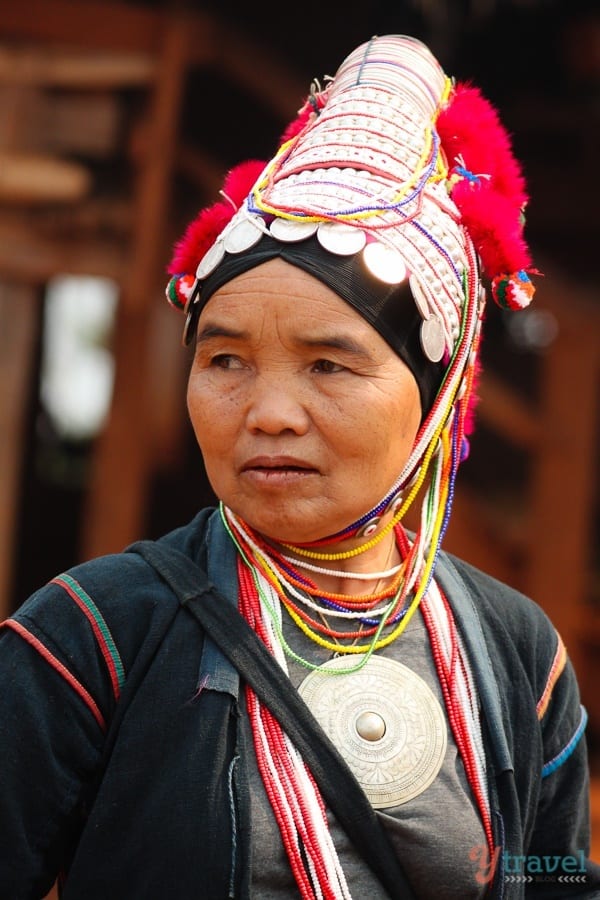
Our guide, in his broken English and with help from our Go Green Thailand guide told us about village life. He took us to see the sacred village Akha swing, used for special celebrations.
Late August every year, at the peak of the rainy season, the colourful Akha people celebrate a four day festival in their villages. It marks the end of the planting of the village rice and is in celebration of all their hard work and the lushness of the earth around them. It’s a joyful time as they show respect and gratitude to their ancestors who bless them with abundance.
It’s also marks the rite of passage for Akha girls passing into womanhood, who dress in the colourful traditional dress of the Akha people and let their hair down swinging wildly through the air on the rickety swing.
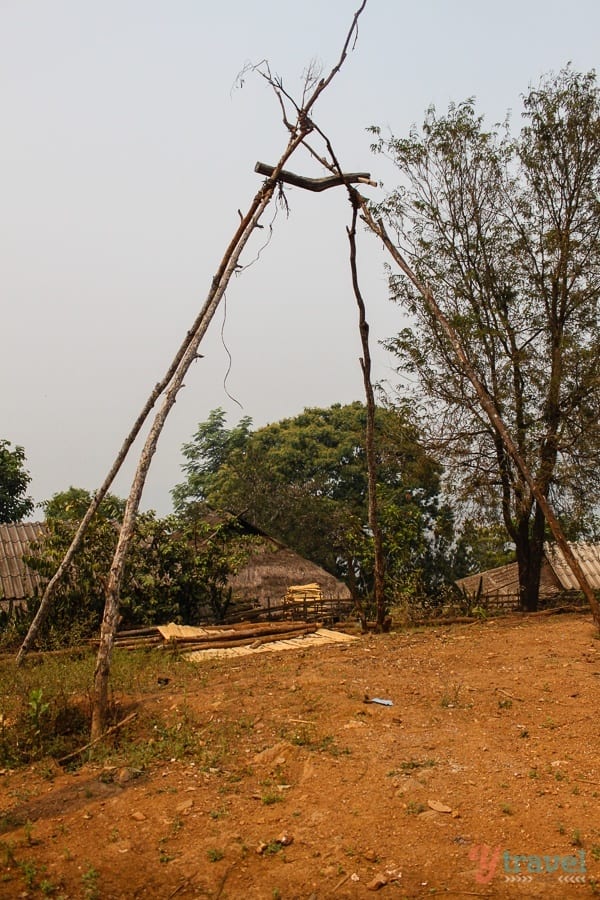
The People
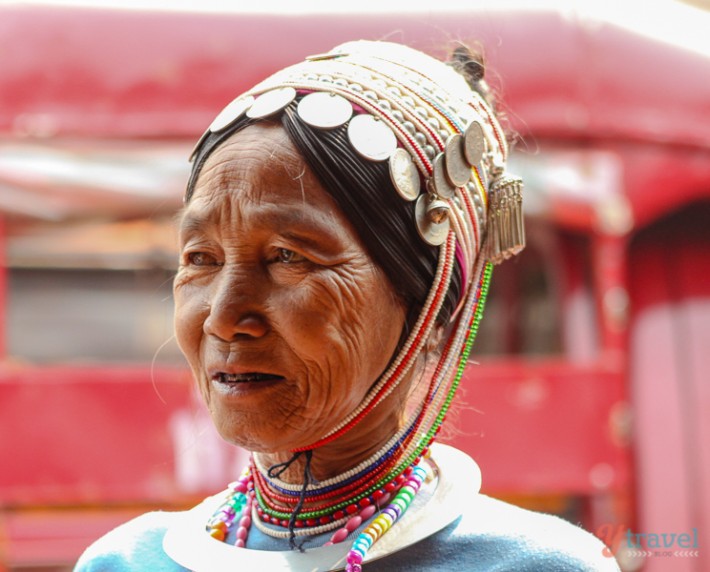
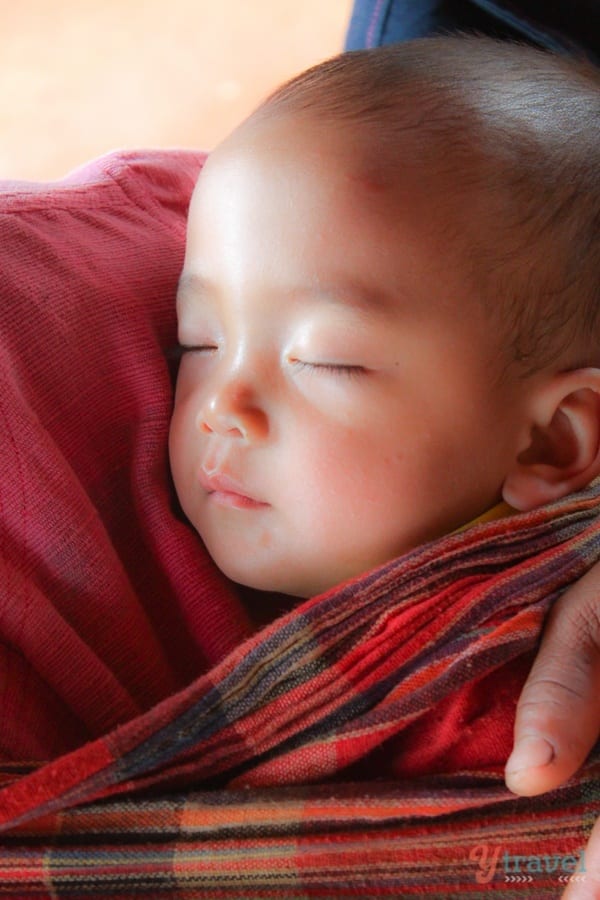
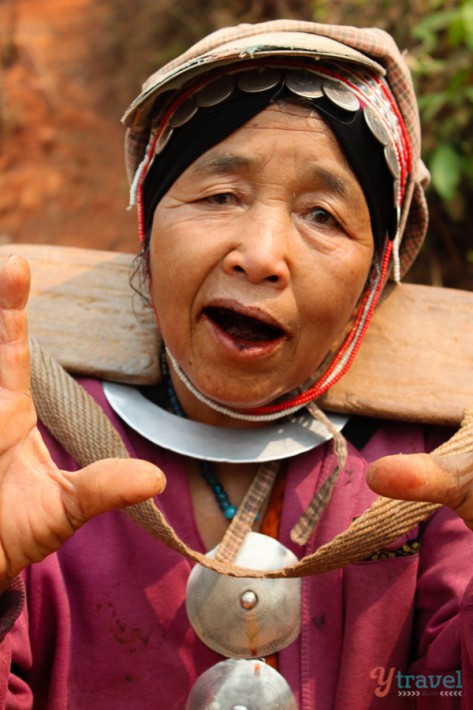
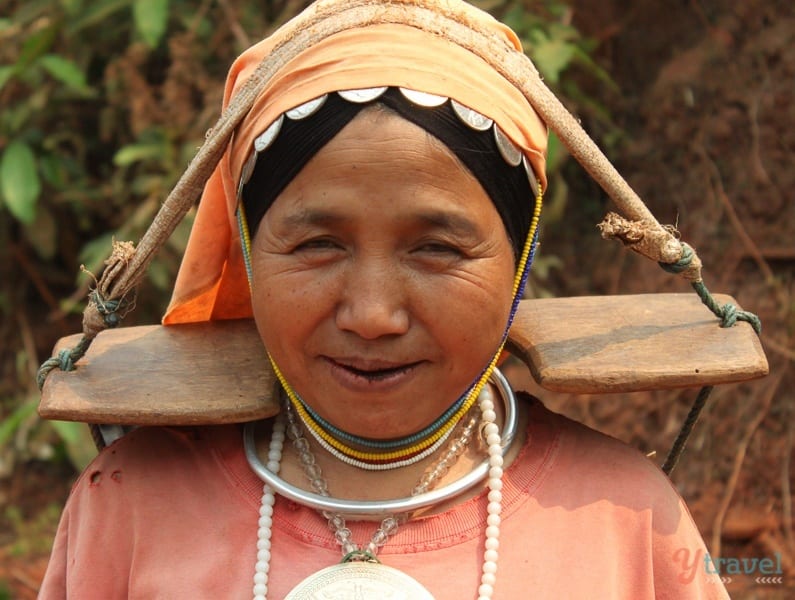
- So sweet and happy
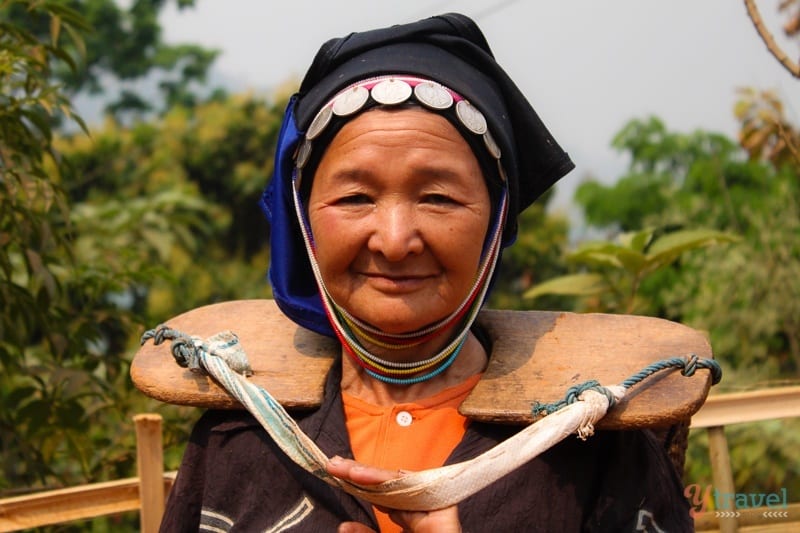
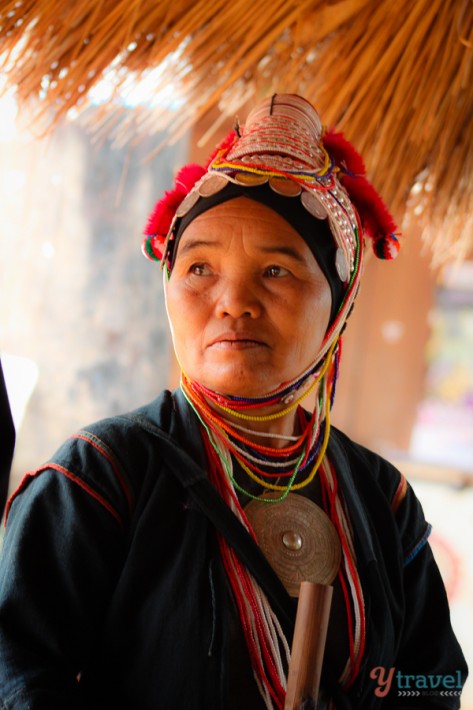
Taking a Walk
The counsel leader and his wife, the village herbal doctor, took us for a short walk in the surrounding forest to get a deeper insight into the self-sufficient village life.
We walked under what looked to be a haphazardly constructed gated entrance to the village, with simplistic grass woven circular designs. We discovered that it was a Spirit Gate designed to keep bad spirits at bay.
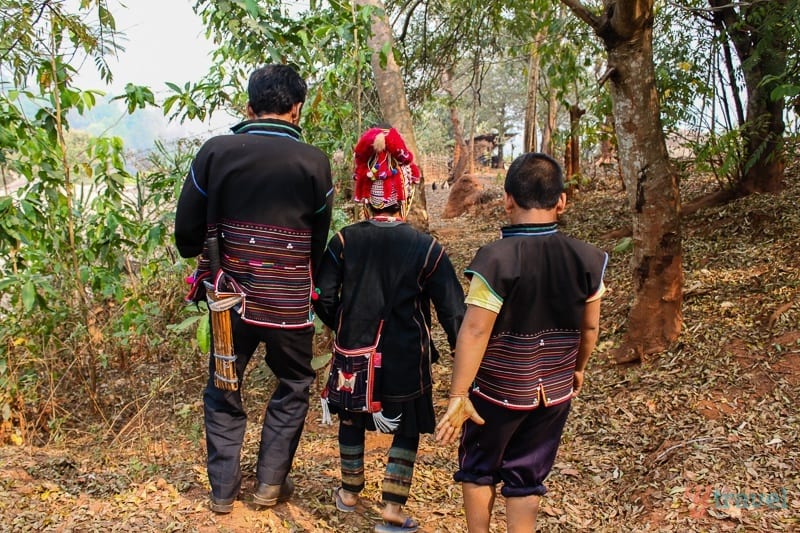
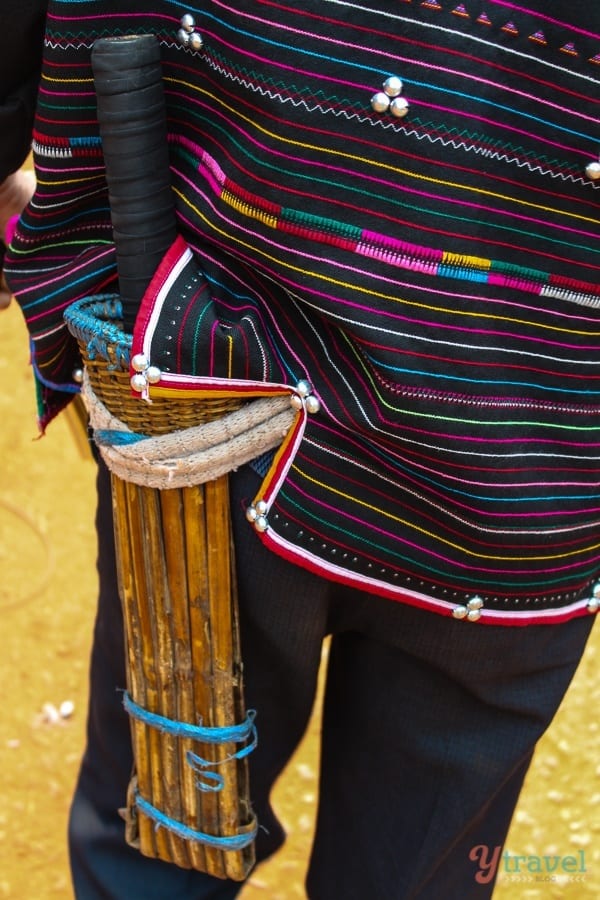
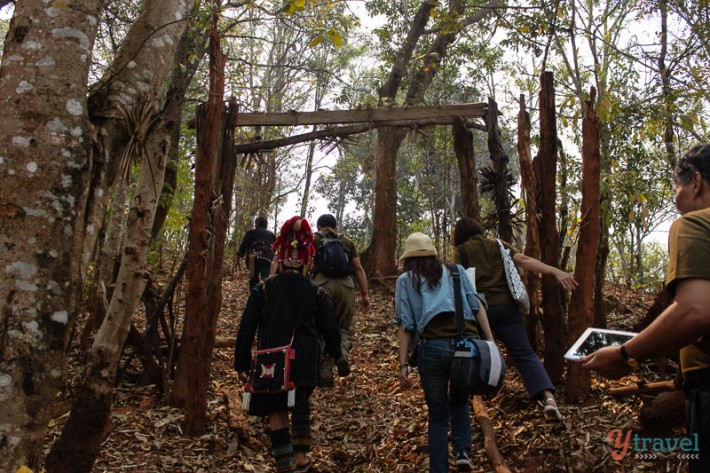
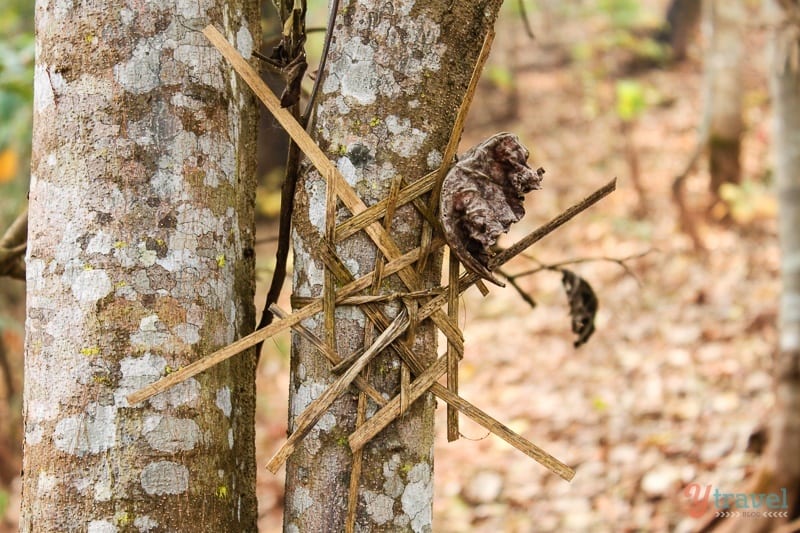
Attaching a ‘spirit eye’ to trees indicates that they must not be cut.
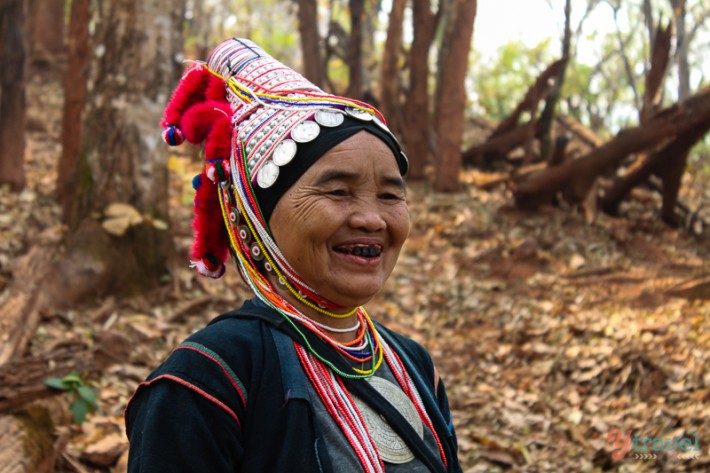
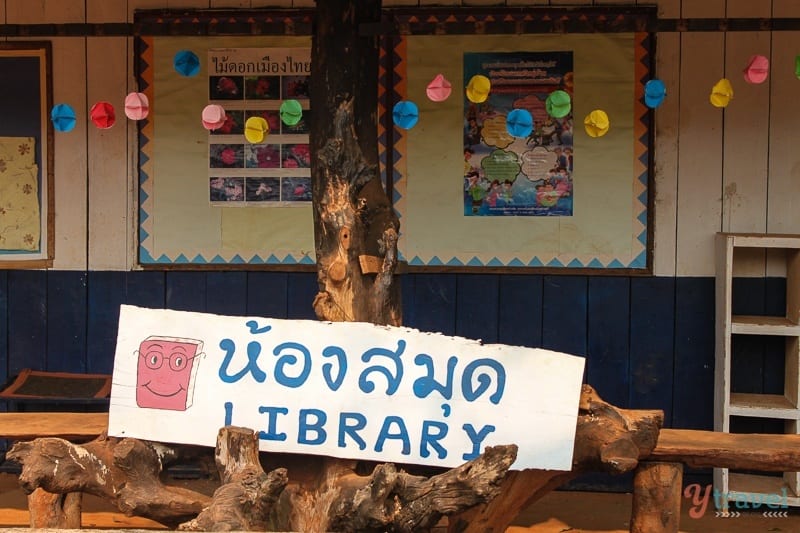
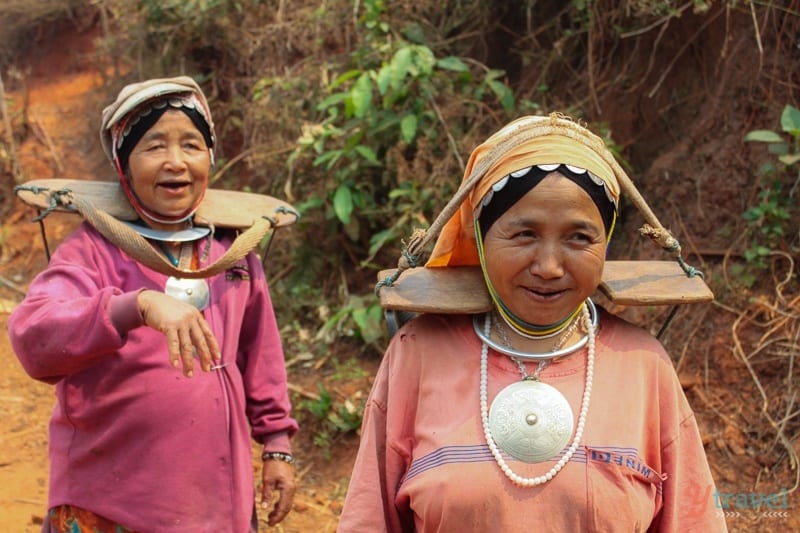
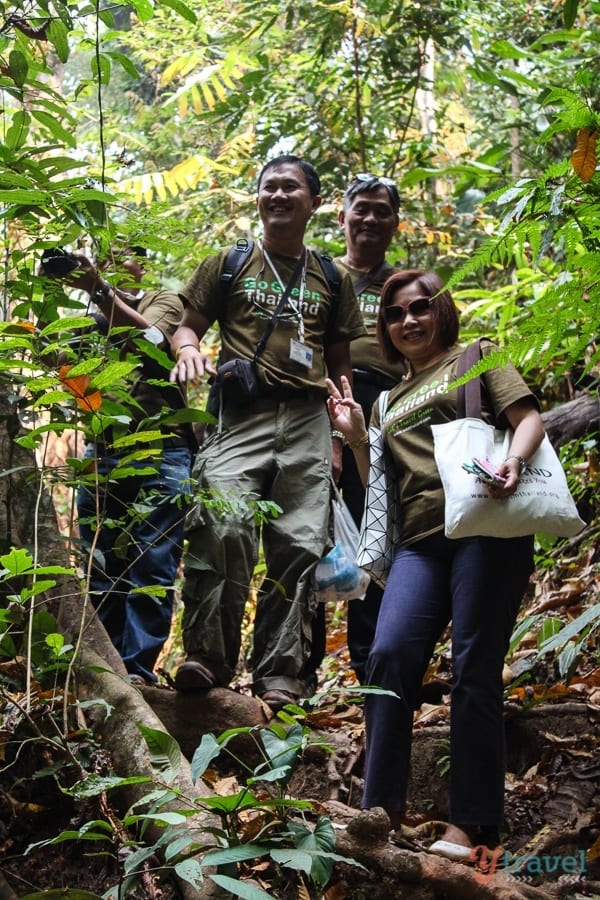
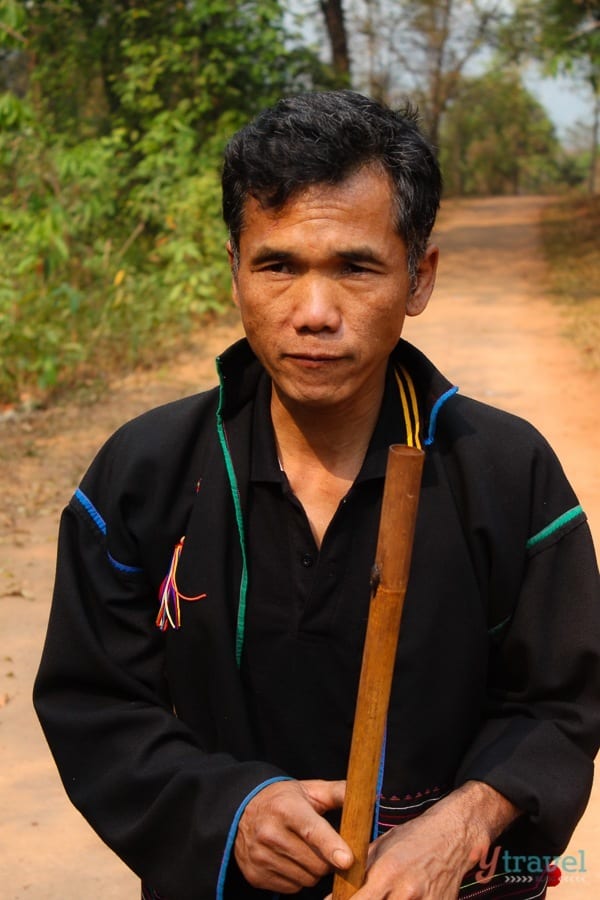
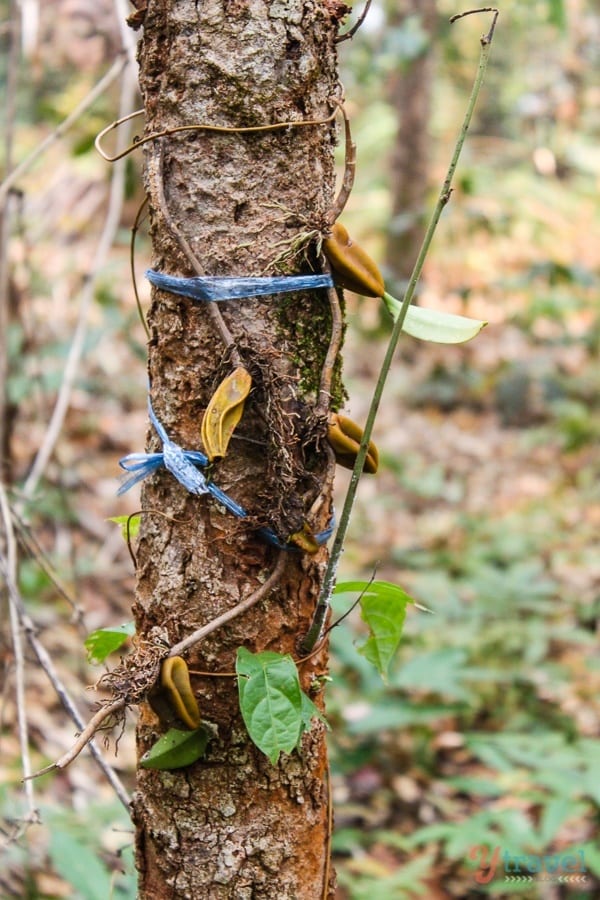
A Healing Opportunity
On our walk tragedy struck when one of our group fell down the mountain and scraped his arm. Our medicine doctor disappeared into the forest and returned soon with a variety of leaf specimens and a larger leaf to act as a petrie dish.
She began rolling and grinding until it formed a paste. Then she gently applied it to his abrasion. It stayed on until we left. It didn’t heal it magically then and there, but it helped relieve his pain and no infection visited for the remainder of our trip. He was very happy with the remedy. I was very happy watching the herbal doctor at work.
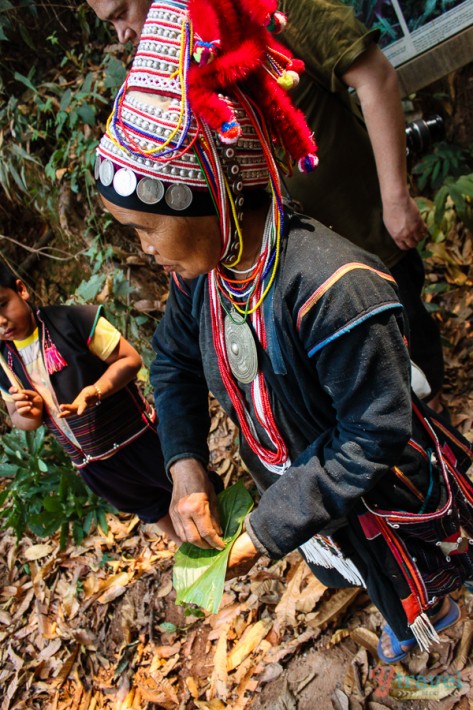
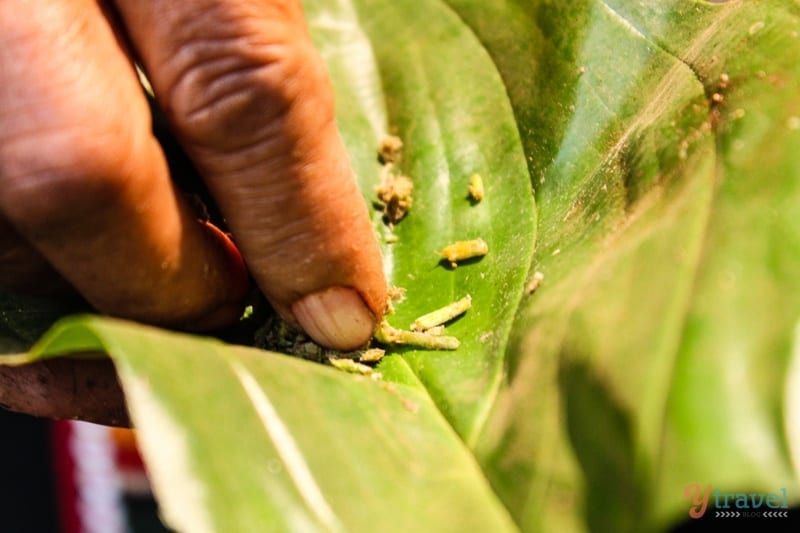
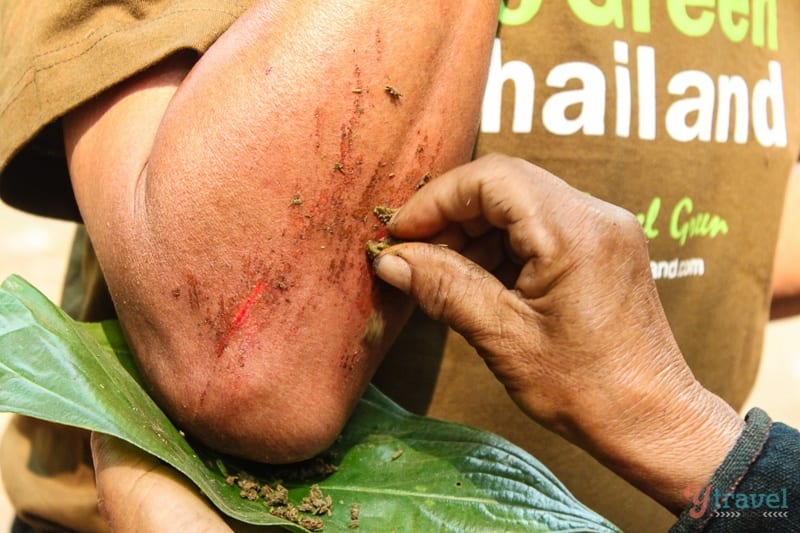
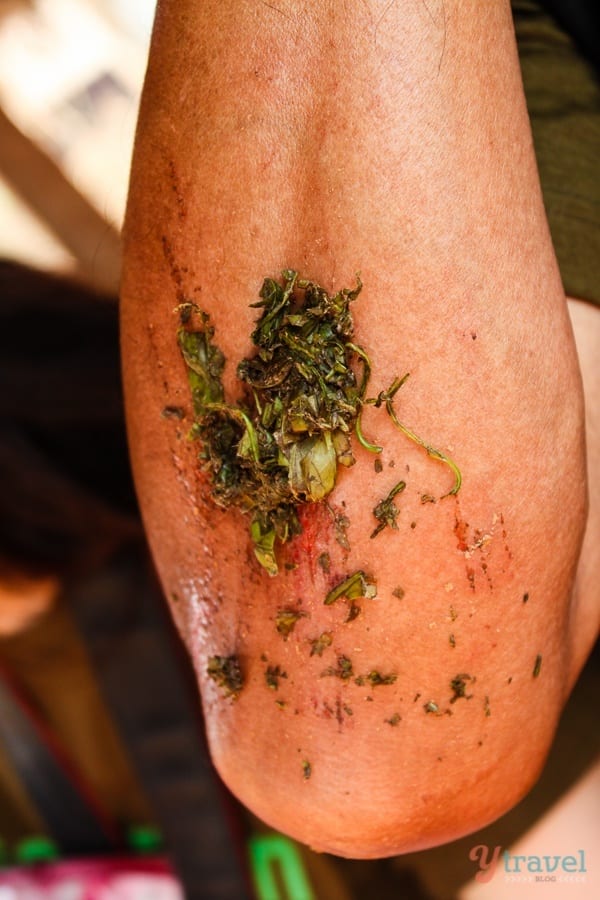
Sharing a Meal Together
After our meal we were invited into the home of a sweet married couple. They prepared a simple meal with food grown in the gardens and village animals, which we ate together on the floor of their living room. Their wooden home was bare, but filled with warmth and happiness.
They could not speak English, but their smiles and kind deeds said so much.
(I was also really happy to see their 4 year old son throw a tantrum–it happens everywhere, we are not alone!!)
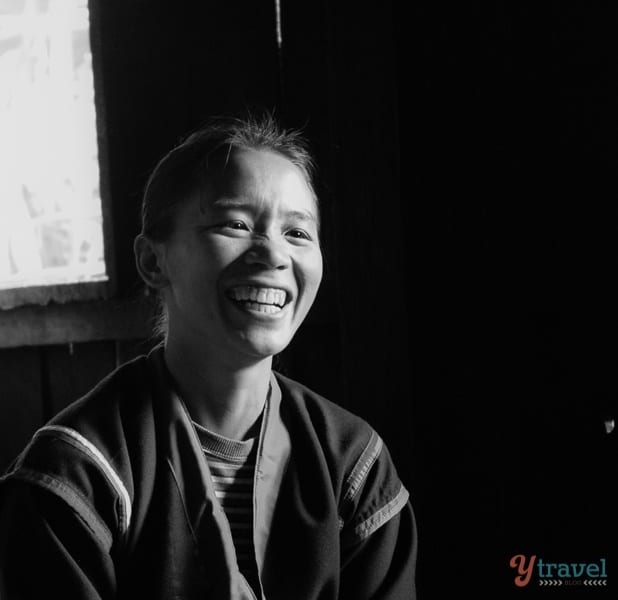
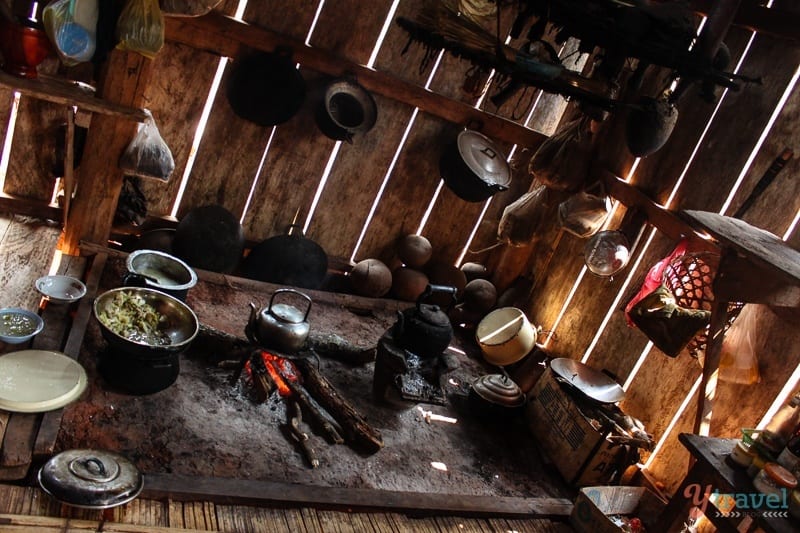
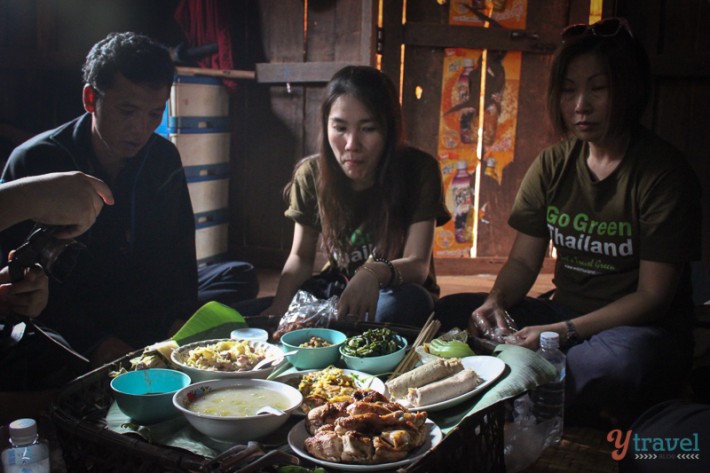
Huay Kee Lek – the Facts
Located in Chiang Rai province, in the Wawi sub-district, approximately 25 km’s from the district center of Mae Souay.
Go Green Thailand offer tours to the village. Visit their website here:
Have you experienced a hill tribe village in Thailand before?
Please share below.
My visit to the Huay Kee Lek Akha village was part of my Friendship to Friend tour with Tourism Thailand.
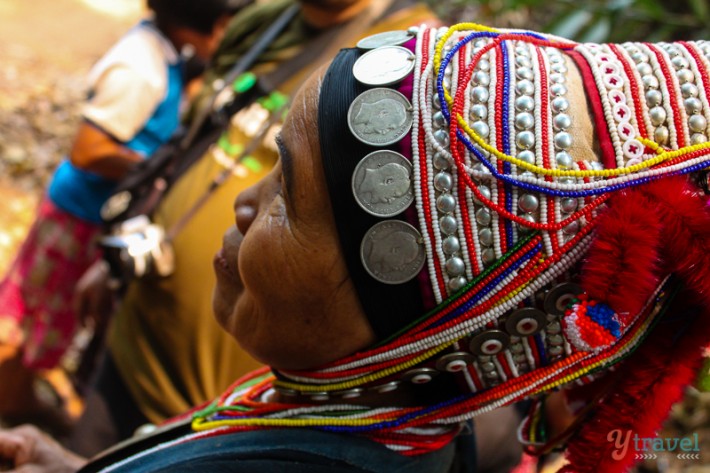
Fabulous to see the management happening in this village so as to prevent the people and their traditions being spoilt with a tourism invasion –
We were lucky enough to go hiking in these hills with a Thai who was teaching up there many (many!) years ago so were privy to a very intimate insight of life in this region.
Love the First Aid 🙂
I’ve stayed with hill tribes north of Chiang Mai on a tour and loved it! One of the best parts of my first trip to Thailand. I was fortunate that it was only one another girl and I in my group, so the tour seemed really personalised.
Fantastic photos! They bring back great memories 🙂 Including when a frog jumped into the pan when they were cooking a traditional meal for us. No-one seemed worried (Except Catherine and I). They just cooked it up and ate it amongst the stir-fry veggies!!
I thought it was amazing to see ‘western’ clothes on most of the children when you have to hike for so many hours into the hills to arrive at the villages. But then our guide did say a few of the men the villages often have small motorbikes that they ride along the walking trails to nearby towns to get some supplies.
We too visited a hill tribe in Thailand, in the Doi Inthanon national park, and had a really lovely experience. The people were genuine and friendly, we had a guided walk through the forest, and endless cups of locally grown coffee. Certainly something we would recommend – delighted to hear you had such a positive experience as well 😀
Sounds great Laurence and what a beautiful spot to visit a Hill Tribe!
Kids really do level the playing field and help break the ice in many situations. It is so easy to interact with them, without the need for language. I am glad you remembered that you had not blogged about this experience. Great photos. Infection could be a real problem with a scrape in the jungle – lucky there was a medicine doctor to treat the wound 🙂
I think visits to the hill tribe villages in northern Thailand can be great cultural experiences for all kinds of travellers – families, solo, friends, couples, young travellers, etc. I also think they’re problematic though.
Sometimes they can be well-managed community based projects. Sometimes they can be more like human zoos with outside operators exploiting the situation and taking most/all the money. It can help to do some research ahead of time to see if anything’s been written (positive or negative) about the situation of the village(s) you’re visiting. At the very least, I’d recommend that visitors buy some handicrafts directly from the locals to ensure that they are benefiting directly from your visit.
I don’t recommend that interested travellers skip them altogether though, and besides being a wonderful travel experience they can also bring much needed income to the villagers. (Yes, I’ve visited multiple villages too!) It just helps to be conscientious about our impact as travellers and to tread carefully when exploring all the cultural and natural wonders that Thailand and other countries offer.
P.S. – While I haven’t been to any hill tribe villages in Mae Sruay, I have been to a Thai village there. The surroundings were absolutely beautiful – gorgeous vibrant green rice paddies, wooden houses, hills in the distance. There’s also a great little restaurant on top of the Mae Sruay Dam… very picturesque views. Not necessarily worth a trip on its own, but if you happen to be in the area… gorgeous.
I know two Western guys who between them have lived in Northern Thailand for over 50 years and do a lot of work to support poor hill tribe children. They have told me a lot about the ‘human zoo’ hill tribe villages where the people are almost prisoners and benefit very little from the tourist hordes who pay to gawk at them. I need to find a tour I can be sure is ethical before I will visit so will check out Go Green Thailand, thanks for that tip.
I’ve visited settlements for (mostly) Shan people displaced from Burma to bring them rice and milk and that’s an eye opener. They live in such poverty and work in such dangerous conditions with pesticides on the plantations growing oranges. I’ve also worked on a small project helping disabled people in a hill tribe village ravaged by methamphetamine and HIV. I tend to think these experiences, though not photo-friendly for tourists who want pretty pictures, are more representative of the situation for many hill tribes than most of the ‘authentic’ hill tribe tours.
Have you visited the Doi Tong Royal Project in Chiang Rai https://www.ytravelblog.com/doi-tung-chiang-rai-thailand/
I think you would love that. I was so inspired by it.
I agree I am married to a ahka woman ans have lived in her village with out tourist. Keping it short is the future is gone utility you can’t blame the the new generation wants to be westren. And we can’t. Blame them. it is selfish for us to keep them in old times when they have access to roads medicine electricity so on. The world has changed ad it makes me mad when we find beauty in something thatis interesting for are knowledge and basically intertainment. The world is changing and the culture is going to change with the youth. it can be perserved but modern world has touched the ahka religion . If you are on a tour look further on the path your on everything is set up for tourist. This also has to do with monisarys there is ups and downs. U du tama de gula hama de. I bow my head to you and chock de…. good luck. I love Thailand but all hill tribes are tretead unfair. If you care read a book from Mathew micdonald called cry freedome.
Hello and thank you for the beautifully written blog about your visit to the hill tribes.
I will be in Northern Thailand next month and would like to visit those people and their village but I cannot get in touch with GOGREEN THAILAND It seems their page has expired, can you help ?
Oh no I can’t unfortunately. I only had that web link for them. Maybe do a bit more google searching and see what you can find.
We would love to visit this village Huay Kee Lek . We will be in Chiang Khong February 7,8,9,
two women traveler
Can you accommodate us?
Many thanks Monique Mailloux Paros Island Greece
Sorry Monique. We’re not travel agents so can’t help you with your trip. Hope you can find the right person
hi.. i tried visiting the Go Green website and didn’t exist. Do you happen to know an updated website I could check out to book a tour?
Went through search and found this old experience you’ve written about – this is really inspiring and I love how honest your writings are. Like many said in the comments above/below, Thai hill tribe tours are detrimental to the local communities if they’re not properly managed. We’re lucky to see more and more care and focus put into these tours to ensure local indigenous cultures are preserved and their environments protected.
Organizations like Community-Based Tourism Institute of Thailand, DASTA, Child Safe, and so much more have done amazing jobs at spreading this remarkable and meaningful experiences to the world while putting down clear, actionable, and sustainable policies with local best interests at their core.
The Tourism Authority of Thailand has given this form of local rural tourism a huge boost with its campaign “Discover Thainess” this year and many large-scale tour agencies and DMC’s are following suit. It’s really encouraging to see large players like Asian Trails, Diethelm, JTB, and more pledging to end inhumane elephant rides, questionable tiger temples, etc.
Good times to be a responsible traveler for sure – it’s our passion to spread these meaningful experiences to others and thank you for doing the same!
This is why I love Thailand. Except for beaches and Bangkok they always has some thing to discover not in tourist radar yet. And it’s good see the tribe is still tying to protect their life style from mass tourism. A sad truth in most part in the world. Thank you for this great article. keep coming these kind of articles, really loved it. Cheers.
After reading your article, and finding the full route to Chiang Rai on this website https://catmotors.net/routes/chiang-rai-loop/ I spent an unforgettable weekend in a trip to Chiang Rai Province. Thanks a lot for tips!
I also have a question related to your website. What is the name of the font you are using, when a comment is written, but when it is not yet published? This font is great and I want to install myself on a blog the same.
Please read “The Tea Girl of Hummingbird Lane,” by Lisa See. Her intimate story of an Akha woman and the cultural norms she must fit into are heart-wrenching. Example, birthing twins is taken as an offensive evil. I don’t want to reveal too much about the book, but Lisa See will stun with this story about an Akha woman.
Thanks for the recommendation.